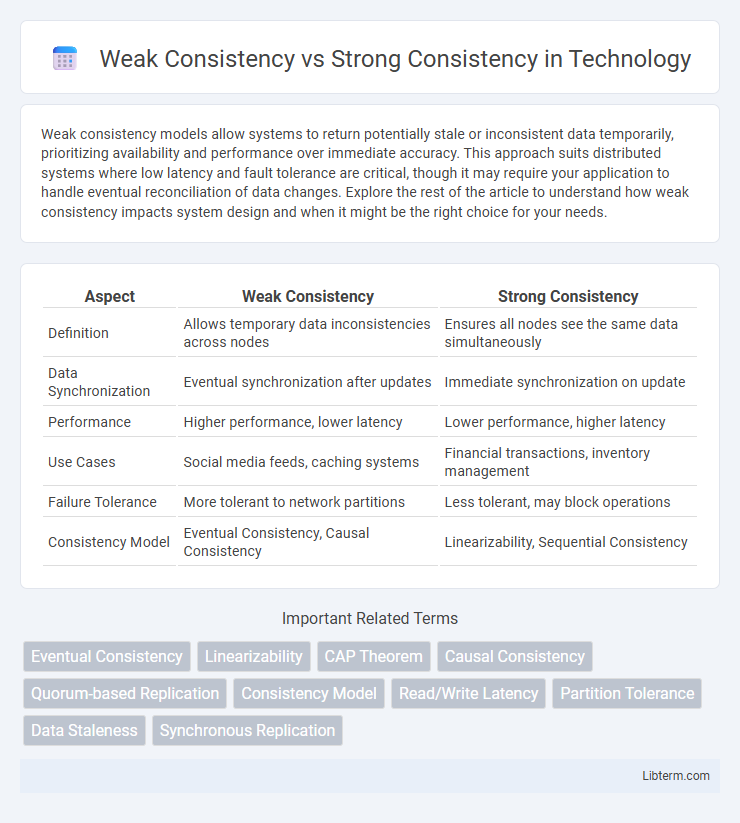Weak consistency models allow systems to return potentially stale or inconsistent data temporarily, prioritizing availability and performance over immediate accuracy. This approach suits distributed systems where low latency and fault tolerance are critical, though it may require your application to handle eventual reconciliation of data changes. Explore the rest of the article to understand how weak consistency impacts system design and when it might be the right choice for your needs.
Table of Comparison
| Aspect | Weak Consistency | Strong Consistency |
|---|---|---|
| Definition | Allows temporary data inconsistencies across nodes | Ensures all nodes see the same data simultaneously |
| Data Synchronization | Eventual synchronization after updates | Immediate synchronization on update |
| Performance | Higher performance, lower latency | Lower performance, higher latency |
| Use Cases | Social media feeds, caching systems | Financial transactions, inventory management |
| Failure Tolerance | More tolerant to network partitions | Less tolerant, may block operations |
| Consistency Model | Eventual Consistency, Causal Consistency | Linearizability, Sequential Consistency |
Understanding Data Consistency Models
Weak consistency allows for temporary discrepancies across distributed systems, enabling higher availability and performance by relaxing synchronization constraints. Strong consistency ensures that all nodes reflect the most recent write, providing a single, up-to-date view of data at all times, but potentially increasing latency and reducing system availability. Understanding the trade-offs between weak and strong consistency is crucial for designing distributed databases and applications that balance reliability, speed, and fault tolerance.
Defining Strong Consistency
Strong consistency ensures that every read operation reflects the most recent write, guaranteeing a single, unified view of the data across all nodes in a distributed system. This model enforces that once a write completes, any subsequent reads will return that updated value, preventing stale or conflicting data states. Strong consistency is critical in scenarios requiring precise accuracy, such as financial transactions or inventory management systems.
Defining Weak Consistency
Weak consistency allows temporary divergence in data across distributed systems, where updates may not be immediately visible to all nodes. This model prioritizes availability and partition tolerance over immediate synchronization, often resulting in faster response times with eventual data convergence. Weak consistency is commonly employed in large-scale distributed databases and cloud storage systems to enhance scalability and fault tolerance.
Key Differences Between Strong and Weak Consistency
Strong consistency ensures that all users see the most recent write immediately after it occurs, guaranteeing data uniformity across distributed systems. Weak consistency allows temporary discrepancies, where reads may return outdated data until synchronization completes. The key difference lies in the trade-off between immediacy of data visibility and system performance, affecting how distributed databases handle latency, availability, and fault tolerance.
Real-World Examples of Consistency Models
Weak consistency is exemplified by systems like DNS, where updates may take time to propagate, causing temporary outdated responses, while strong consistency is seen in banking systems requiring immediate transaction synchronization to prevent anomalies. Distributed databases such as Cassandra implement eventual consistency, a form of weak consistency, allowing temporary divergence but guaranteeing convergence over time. In contrast, systems like Google's Spanner provide strong consistency by leveraging synchronized clocks to ensure globally ordered transactions.
Advantages and Disadvantages of Strong Consistency
Strong consistency ensures that all users see the most recent write, providing reliable and predictable data access critical for financial transactions and inventory management systems. The primary advantage is data accuracy and synchronization across distributed nodes, preventing stale reads and conflicts. However, strong consistency can introduce increased latency and reduced system availability, particularly in distributed environments where network partitions occur, limiting performance and scalability.
Advantages and Disadvantages of Weak Consistency
Weak consistency offers advantages such as improved system availability and lower latency by allowing read and write operations to proceed without waiting for global synchronization. This model reduces communication overhead and enhances performance, especially in distributed and large-scale systems. However, weak consistency may lead to stale or inconsistent data views, making it unsuitable for applications requiring immediate accuracy and synchronization across replicas.
When to Choose Strong vs Weak Consistency
Strong consistency ensures that all clients see the most recent write, making it ideal for financial transactions, inventory management, and other applications where accuracy and up-to-date data are critical. Weak consistency offers higher availability and lower latency by allowing some delay in synchronization, which suits social media feeds, caching, and scenarios where eventual correctness is acceptable. Choose strong consistency when data correctness and immediate visibility are paramount; opt for weak consistency to enhance performance and scalability in distributed systems with relaxed accuracy requirements.
Impact of Consistency on System Performance
Weak consistency models improve system performance by allowing more flexible and faster data replication across distributed nodes, reducing latency and increasing availability. Strong consistency ensures all nodes reflect the same data simultaneously, which can significantly increase synchronization overhead and response time. Trade-offs between consistency levels affect throughput; weak consistency favors higher throughput at the cost of potential stale reads, while strong consistency guarantees data accuracy but imposes stricter communication and processing delays.
Consistency Models in Modern Distributed Systems
Weak consistency models in modern distributed systems prioritize availability and partition tolerance by allowing temporary data divergence, which improves system responsiveness under network failures. Strong consistency models ensure immediate data uniformity across all replicas, enforcing strict synchronization that guarantees read-after-write consistency at the cost of higher latency. The choice between weak and strong consistency directly impacts system design trade-offs related to CAP theorem and dictates application behavior in distributed databases and cloud services.
Weak Consistency Infographic

 libterm.com
libterm.com